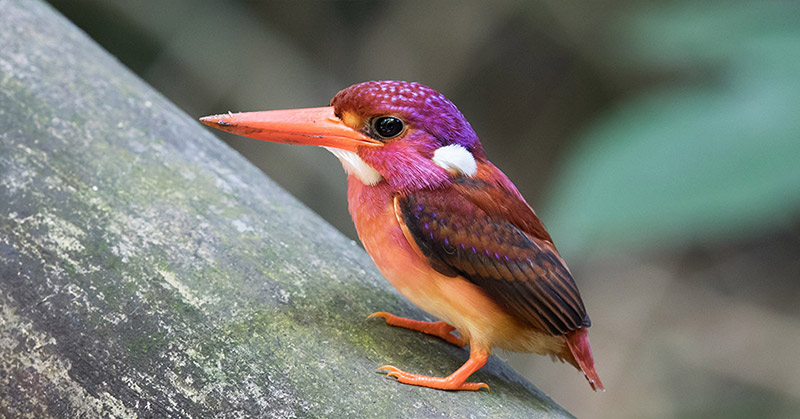130 years after being recorded for the first time, we finally have the first-ever photograph of the South Philippine Dwarf Kingfisher, a beautiful little bird native to the Philippines. (1)
No Photos, please!
This brightly colored bird is the smallest of the species of birds known as the King Fishers. It’s so tiny and so quick as it darts from branch to branch that scientists have never been able to capture it on film. (1)
It was first described in 1890 during the Steele expedition to the Philippines as having a metallic-like quality to its orange and purple-colored feathers and bright blue spots. Its chirp is as unique as its appearance, making a zeeep sound that is high-pitched and nearly undetectable to the human ear. (1)
Until now, we have only had written descriptions of the bird that was too quick for the camera. Thanks to Filipino biologist Miguel David de Leon, we now have photos of this gorgeous species of the Kingfisher. (1)
Read: Motherly Hummingbird Builds a Home With A Roof to Protect her Chicks
The Robert S. Kennedy Bird Conservancy
Miguel is the director of the Robert S. Kennedy Bird Conservancy. This is a group of eight field biologists and bird photographers who are dedicated to birds and their habitats. Their goal is to contribute data otherwise unknown to help conserve species and their ecosystems. (1)
The researchers spent an entire decade tracking the Dwarf Kingfisher, and thanks to their hard work we now not only have images of the bird but also valuable information on their species and habitat. (1)
A bird in trouble
The dwarf kingfishers are cavity nesters, meaning they dig tiny holes in the earth to build their nests. They feed primarily on insects, earthworms, small lizards, and other invertebrates. (1)
Unfortunately, the stunning little bird is under threat of extinction due to loss of habitat. (1, 2, 3, 4)
When habitats are destroyed it causes repercussions all the way down the food chain (1):
- The fungi and bacteria that create proper soil are gone, so plants and shrubs cannot grow.
- These plants and shrubs are the homes and food sources for thousands (if not more) species of insects.
- Those insects are what the birds and other creatures feed on. If they are gone, the birds will also begin to disappear.
As you can see, the conservation of the virgin and second-growth forests of the Philippines is crucial not just to the survival of the South Philippine Dwarf Kingfisher and many other insects, plant, and animal species that reside there.
Read: Dozens of Creatures Thought to Be Extinct Found Alive in ‘Lost City’ in the Jungle
How you can help
The best way you can help conserve these important ecosystems is to make your own life more sustainable:
- Buy local and organic foods whenever possible.
- Stop using single-use plastic.
- Quit fast fashion and shop at sustainable clothing retailers or thrift stores.
- Conserve water.
- Use natural cleaning products, cosmetics, and toiletries.
- Eat less meat, and when you do, make sure it is sustainably sourced.
- Walk, bike, and take public transit whenever possible.
- Purchase fuel-efficient and clean-energy vehicles.
These are just a few of the hundreds of ways you can make your life more sustainable. Remember: Every little bit counts. We don’t need a few people doing sustainability perfectly, we need everyone doing it as best they can.

